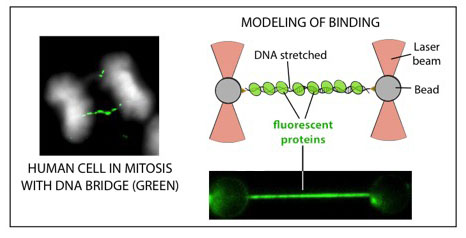Biologists join forces with physicists to explain how DNA gets separated during cell division.
In a new study, researchers from Ian Hickson’s group in the Center for Chromosome Stability at the Department of Cellular and Molecular Medicine joined forces with a team of physicists from the Free University, Amsterdam to discover how the final stages of DNA separation occurs during mitotic cell division in human cells.
During the process of cell division, it is imperative that the two daughter cells each receive an identical copy of the mother’s genome. This equal partitioning of the DNA is frequently challenged by the presence of persistent DNA linkages between the segregating DNAs. The unfortunate outcome of this, if not corrected, is that these linkages generate DNA bridges that prevent timely DNA segregation by tethering the two daughter DNA masses together. The vast majority of these DNA bridges are of a type called ultra-fine bridges (UFBs) because they are invisible even when cells are stained with DNA dyes. UFBs can only be detected by the use of antibodies specific for proteins that localize to the bridge DNA. Most of these proteins are involved in DNA repair or more directly in DNA unlinking processes, which are called topoisomerases.
The study by Sarlós et al., which has been published in the scientific journal Nature Structural and Molecular Biology, describes the use of a research tool based on so called optical tweezers to model how UFB binding proteins recognize the DNA and recruit other proteins to carry out the DNA unlinking (see Figure). Through using a model of a UFB in anaphase consisting of a DNA molecule suspended between two beads held by laser beams, the researchers were able to use an advanced microfluidic flow cell to expose the DNA sequentially to different fluorescently labeled proteins while the sample was being imaged at high resolution. The results of the study define how a UFB binding protein called PICH is the main player in recognizing the DNA in the first place. PICH then recruits the DNA unlinking machinery comprising BLM (the protein defective in a disorder called Bloom’s syndrome that is associated with dwarfism and a high incidence of cancer) and Topoisomerase IIIa. Recent work from this research group also showed that Topoisomerase III deficient persons suffer from a form of dwarfism similar to that seen in Bloom’s, which is associated with severe microcephaly (a small skull and brain). It is hoped that future studies will shed light on how UFB binding proteins suppress these genetic disorders in humans.

Reference:
Sarlós, K., Biebricher, A.S., Bizard, A.H., Bakx, J.A.M., Ferrete-Bonastre, A.G., Modesti, M., Paramasivam, M., Yao, Q., Peterman, E.J.G., Wuite, G.J.L. and Hickson, I.D. (2018) Reconstitution of anaphase DNA bridge recognition and disjunction in vitro. Nature Structural and Molecular Biology 25, 868-876.
